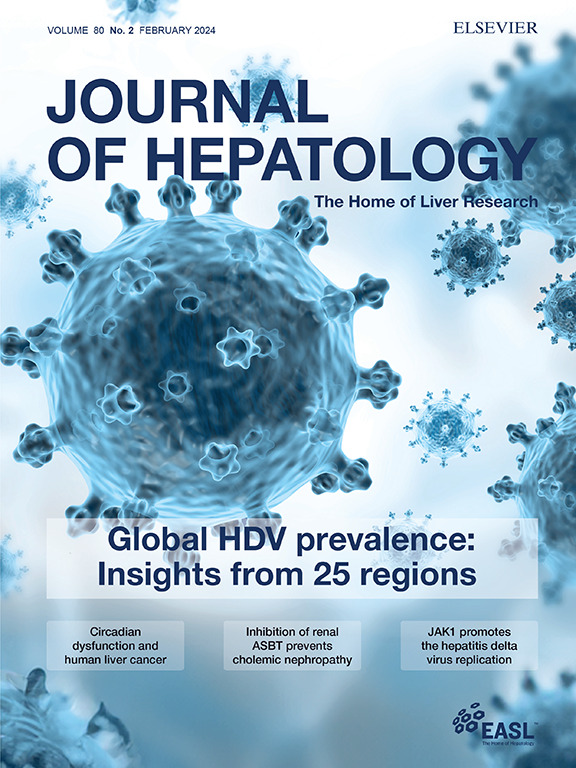Liposomal irinotecan for previously treated patients with biliary tract cancer: A pooled analysis of NIFTY and NALIRICC trials
IF 26.8
1区 医学
Q1 GASTROENTEROLOGY & HEPATOLOGY
引用次数: 0
Abstract
Background & Aim
Liposomal irinotecan (nal-IRI) combined with fluorouracil (5-FU)/leucovorin (LV) as a second-line treatment for biliary tract cancer (BTC) following progression on gemcitabine-based therapy in the Korean NIFTY and German NALIRICC trials yielded conflicting outcomes. This necessitated a comprehensive pooled analysis to evaluate its efficacy and safety.Methods
Individual patient data were pooled from the intention-to-treat populations of the NIFTY and NALIRICC trials. The primary endpoint was progression-free survival (PFS).Results
A total of 278 patients were included: 137 in the nal-IRI plus 5-FU/LV group and 141 in the 5-FU/LV group. The nal-IRI plus 5-FU/LV group showed significantly longer median PFS (3.6 months [95% confidence interval [CI], 2.7–4.4] vs 1.8 months (95% CI, 1.5–2.6), hazard ratio [HR) 0.65, p<0.001). Median overall survival was 8.1 months (95% CI, 6.0–8.9) and 6.1 months (95% CI, 5.3–7.5), respectively (HR 0.77, p=0.051). Overall response rates (ORR) was also higher in the nal-IRI plus 5-FU/LV group (17.5% vs 2.8%; p<0.001) than in the 5-FU/LV group. Post-study irinotecan-containing therapy was administered in 4 (2.9%) and 21 (15.3%) patients in the nal-IRI plus 5-FU/LV group and 5-FU/LV group, respectively. Adverse events varied by ethnicity, with gastrointestinal toxicities more common in Germans and neutropenia more prevalent in Koreans; treatment discontinuation without disease progression was 31.3% vs 8.0%, respectively.Conclusion
The addition of nal-IRI to 5-FU/LV significantly improved PFS and ORR, supporting its potential as subsequent-line therapy. Differences in safety profiles underscore the relevance of ethnicity for nal-IRI in patients with BTC.Impact and implications
Current standard of care for second-line therapy in patients with advanced biliary tract cancer (BTC) is FOLFOX. This study provides robust evidence supporting the potential role of additional liposomal irinotecan (nal-IRI) to fluorouracil and leucovorin (5-FU/LV) as a subsequent therapy for patients with BTC who have progressed on gemcitabine-based regimens. The findings demonstrate significant improvements in progression-free survival and overall response rates, emphasizing its potential to address the limited treatment options in this patient population. Furthermore, the study underscores the necessity of considering ethnic differences in adverse event profiles to optimize treatment administration and patient outcomes.Clinical Trial Registration number
NCT03524508 and NCT03043547

求助全文
约1分钟内获得全文
求助全文
来源期刊

Journal of Hepatology
医学-胃肠肝病学
CiteScore
46.10
自引率
4.30%
发文量
2325
审稿时长
30 days
期刊介绍:
The Journal of Hepatology is the official publication of the European Association for the Study of the Liver (EASL). It is dedicated to presenting clinical and basic research in the field of hepatology through original papers, reviews, case reports, and letters to the Editor. The Journal is published in English and may consider supplements that pass an editorial review.
 求助内容:
求助内容: 应助结果提醒方式:
应助结果提醒方式:


